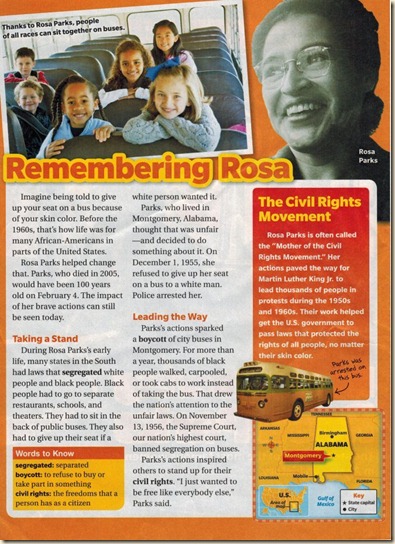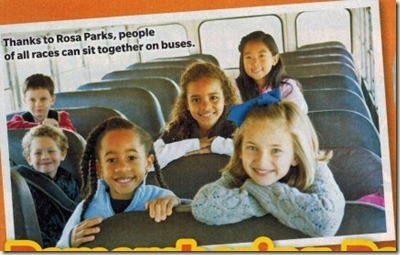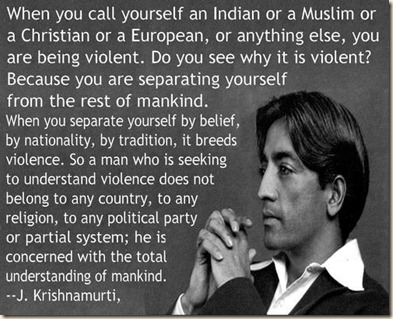My daughter brought this home from school the other day. It’s from a February 2013 edition of Scholastic News (a.k.a., Weekly Reader).

Let’s . . . unpack this a bit.
Imagine being told to give up your seat on a bus because of your skin color.
Because race = “skin color”.
Before the 1960s, that’s how life was for may African-Americans in parts of the United States. Rosa Parks helped change that. Parks, who died in 2005, would have been 100 years old on February 4. The impact of her brave actions can still be seen today.
Indeed.
Parks, who lived in Montgomery, Alabama, thought that was unfair – and decided to do something about it.
This, I will allow, is a more accurate portrait of events than I received from the textbooks of my own youth: Rosa Parks was an innocent old lady who sat at the front of the bus because she was tired. But still nothing about her longstanding activism with the NAACP, nothing about its search for a compelling test case, nothing about Claudette Colvin. And no, none of this makes a difference if your prior is that segregation was The Worst Thing In The World. So why not tell the whole story.
In researching this post, I learned (or rather, confirmed one of several different accounts that I had heard but hadn't bothered to check) the details of Montgomery's bus segregation policy. There wasn't actually a "Black section" and a "White section". Whites filled up the bus from the front working back. Blacks had to pay their fares at the front, then exit the bus to go the rear entrance (running the non-zero probability that the low-status, troglodytic driver would simply leave them -- this actually happened to Parks some years before her protest), and fill the bus towards the front. When the bus filled, the forward most Black row had to leave their seats for the benefit of White passengers.
Now, this might not be as bad as it sounds, since in this scenario there could be vacant seats in the back as Blacks had got off. But in none of the accounts did I read that White passengers extended the same courtesy to Blacks by moving forward for empty seats. The (all-white) bus drivers had full discretion on how to reseat passengers to enforce segregation, and there isn't much evidence that they did this fairly. Even an unreconstructed segregationist should admit that this violates the spirit of Plessy. And in fact, at least initially, the Montgomery Bus Boycott only asked for a fixed demarcation.
Segregated public busses were declared unconstitutional by a Federal District Court in Browder vs. Gayle (ironically, a case to which Rosa Parks was not herself a party). The decision was (apparently) upheld on appeal with no further opinions issued (that I can find). The reason I mention this is that the District Court's majority opinion included these paragraphs:
The ultimate question is whether the statutes and ordinances requiring the segregation of the white and colored races on the common carrier motor buses in the City of Montgomery and its police jurisdiction are unconstitutional and invalid. Unless prohibited by the Constitution of the United States, the power to require such segregation is reserved to the States or to the people. -- See Tenth Amendment.
In their private affairs, in the conduct of their private businesses, it is clear that the people themselves have the liberty to select their own associates and the persons with whom they will do business, unimpaired by the Fourteenth Amendment. The Civil Rights Cases, 109 U.S. 3, 3 S.Ct. 18, 27 L.Ed. 835. Indeed, we think that such liberty is guaranteed by the due process clause of that Amendment.
There is, however, a difference, a constitutional difference, between voluntary adherence to custom and the perpetuation and enforcement of that custom by law. Shelley v. Kraemer, 334 U.S. 1, 13, 68 S.Ct. 836, 92 L.Ed. 1161. The Fourteenth Amendment provides that 'No State shall deprive any person of life, liberty, or property, without due process of law; nor deny to any person within its jurisdiction the equal protection of the laws.'
I'd like to poll those judges as to their opinions of what "Civil Rights" has now become.
But back to the Weekly Reader. It was the picture that . . . set me off:

This picture is mendacious in every possible respect. Never mind segregation for a second. For whom among my readers is this photograph representative of your public school bus experience? In what respect? Demographically? (Two white boys, two café au lait girls, one Asian girl, on white girl.) The smiling faces? The ample space? Or was it, like mine, an overcrowded dystopian hell?*
And using a yellow school bus, that symbol of judicial imposition of racial quotas, to illustrate the desegregation of public city buses? If school buses were even much in use prior to Swann vs Mecklenberg, I can't find a record of it.
The Black Riots of the 1960s were explained (back when I was studying them in college) as a product of “disappointed expectations”. But what about the expectations of Whites? What about the promise of racial peace implicit in the Civil Rights Vision** that we thought we were getting in exchange for dismantling the apparatus of segregation and discrimination? But of course, we aren’t permitted to complain about the lies and propaganda. All we can do is remonstrate some more at BJU.
* Honestly, given the vastly higher safety standards for vehicles since the 70’s, I can’t believe these deathtraps are still on the road.
** In contrast to present-day hagiographies, a look at the contemporaneous reporting shows that there was a lot of diversity among Civil Rights leaders as to what their ends and means should actually be, and that not only was King’s “Content of our Character” vision especially representative of the movement, it wasn’t even consistently advocated by King himself. But that was the vision that White America bought.







